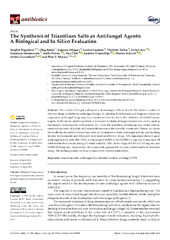Приказ основних података о документу
The Synthesis of Triazolium Salts as Antifungal Agents: A Biological and In Silico Evaluation.
| dc.creator | Pogrebnoi, Serghei | |
| dc.creator | Radul, Oleg | |
| dc.creator | Stingaci, Eugenia | |
| dc.creator | Lupascu, Lucian | |
| dc.creator | Valica, Vladimir | |
| dc.creator | Uncu, Livia | |
| dc.creator | Smetanscaia, Anastasia | |
| dc.creator | Petrou, Anthi | |
| dc.creator | Ćirić, Ana | |
| dc.creator | Glamočlija, Jasmina | |
| dc.creator | Soković, Marina | |
| dc.creator | Geronikaki, Athina | |
| dc.creator | Macaev, Fliur Z. | |
| dc.date.accessioned | 2022-06-08T09:36:10Z | |
| dc.date.available | 2022-06-08T09:36:10Z | |
| dc.date.issued | 2022 | |
| dc.identifier.issn | 2079-6382 | |
| dc.identifier.uri | https://www.mdpi.com/2079-6382/11/5/588 | |
| dc.identifier.uri | http://radar.ibiss.bg.ac.rs/handle/123456789/4982 | |
| dc.description.abstract | The control of fungal pathogens is increasingly difficult due to the limited number of effective drugs available for antifungal therapy. In addition, both humans and fungi are eukaryotic organisms; antifungal drugs may have significant toxicity due to the inhibition of related human targets. Furthermore, another problem is increased incidents of fungal resistance to azoles, such as fluconazole, ketoconazole, voriconazole, etc. Thus, the interest in developing new azoles with an extended spectrum of activity still attracts the interest of the scientific community. Herein, we report the synthesis of a series of triazolium salts, an evaluation of their antifungal activity, and docking studies. Ketoconazole and bifonazole were used as reference drugs. All compounds showed good antifungal activity with MIC/MFC in the range of 0.0003 to 0.2/0.0006-0.4 mg/mL. Compound 19 exhibited the best activity among all tested with MIC/MFC in the range of 0.009 to 0.037 mg/mL and 0.0125-0.05 mg/mL, respectively. All compounds appeared to be more potent than both reference drugs. The docking studies are in accordance with experimental results. | |
| dc.publisher | Basel: MDPI | |
| dc.relation | info:eu-repo/grantAgreement/MESTD/inst-2020/200007/RS// | |
| dc.relation | Moldovan State Program | |
| dc.rights | openAccess | |
| dc.rights.uri | https://creativecommons.org/licenses/by/4.0/ | |
| dc.source | Antibiotics (Basel, Switzerland) | |
| dc.subject | CYP51 | |
| dc.subject | Antifungal | |
| dc.subject | Docking | |
| dc.subject | Microdilution method | |
| dc.subject | Triazolium salts | |
| dc.title | The Synthesis of Triazolium Salts as Antifungal Agents: A Biological and In Silico Evaluation. | |
| dc.type | article | en |
| dc.rights.license | BY | |
| dc.rights.holder | © 2022 by the authors. Licensee MDPI, Basel, Switzerland. | |
| dc.citation.issue | 5 | |
| dc.citation.volume | 11 | |
| dc.identifier.doi | 10.3390/antibiotics11050588 | |
| dc.identifier.pmid | 35625232 | |
| dc.identifier.scopus | 2-s2.0-85129845140 | |
| dc.identifier.wos | 000802356400001 | |
| dc.citation.apa | Pogrebnoi, S., Radul, O., Stingaci, E., Lupascu, L., Valica, V., Uncu, L., et al. (2022). The Synthesis of Triazolium Salts as Antifungal Agents: A Biological and In Silico Evaluation. Antibiotics (Basel, Switzerland), 11(5), 588. | |
| dc.citation.vancouver | Pogrebnoi S, Radul O, Stingaci E, Lupascu L, Valica V, Uncu L, Smetanscaia A, Petrou A, Ćirić A, Glamočlija J, Soković M, Geronikaki A, Macaev FZ. The Synthesis of Triazolium Salts as Antifungal Agents: A Biological and In Silico Evaluation. Antibiot (Basel, Switzerland). 2022;11(5):588. | |
| dc.citation.spage | 588 | |
| dc.type.version | publishedVersion | |
| dc.identifier.fulltext | https://radar.ibiss.bg.ac.rs/bitstream/id/10623/antibiotics-11-00588-v2.pdf | |
| dc.citation.rank | M21 |

